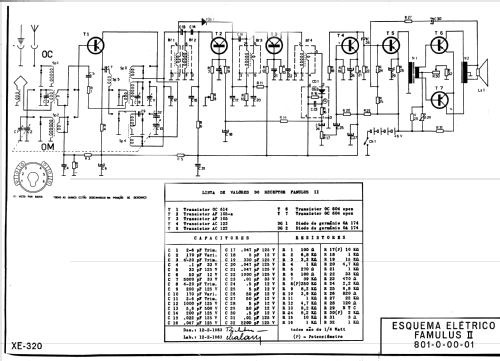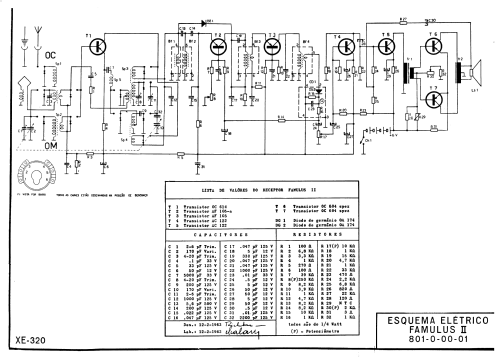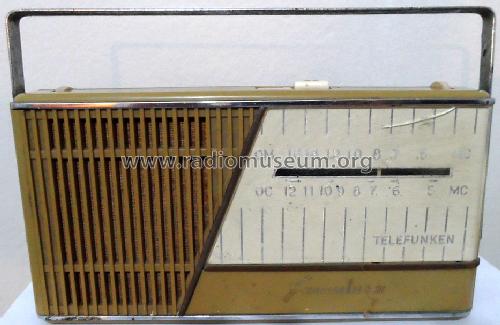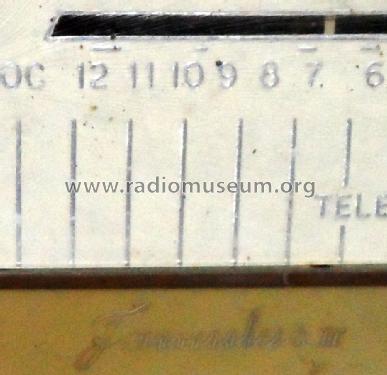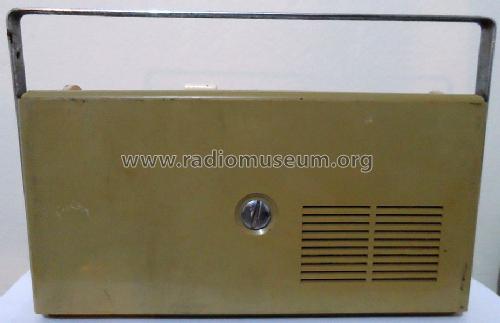- País
- Brasil
- Fabricante / Marca
- Telefunken do Brasil S.A.; Rio de Janeiro, São Paulo
- Año
- 1962/1963

- Categoría
- Radio - o Sintonizador pasado WW2
- Radiomuseum.org ID
- 227350
Haga clic en la miniatura esquemática para solicitarlo como documento gratuito.
- Numero de transistores
- 7
- Principio principal
- Superheterodino en general; ZF/IF 460 kHz; 3 Etapas de AF
- Número de circuitos sintonía
- 6 Circuíto(s) AM
- Gama de ondas
- OM y OC
- Tensión de funcionamiento
- Pilas / 4 × 1,5 Volt
- Altavoz
- Altavoz dinámico (de imán permanente) / Ø 9 cm = 3.5 inch
- Potencia de salida
- 0.3 W (unknown quality)
- Material
- Plástico moderno (Nunca bakelita o catalina)
- de Radiomuseum.org
- Modelo: Famulus II - Telefunken do Brasil S.A.; Rio
- Forma
- Portátil > 20 cm (sin la necesidad de una red)
- Ancho, altura, profundidad
- 240 x 120 x 50 mm / 9.4 x 4.7 x 2 inch
- Anotaciones
-
The original schematic of this Telefunken model Famulus II is from February 12, 1963 and this original semiconductor set up is shown. Telefunken made a Famulus 3971 in Germany from 1958 to 1961, but with the following semiconductors: OC613 OC612 OC612 OC602 OC604 OC604spez OC604spez OA174 OA174. We can imagine that the moulds and machinery was then shipped to Brazil to produce much cheaper for Brazil and probably also for Export from Brazil, by changing the electric part only because at that time it was easy to include short waves instead of long waves. Compare also the very first transistor radio from Telefunken in Germany, the Partner TR1.
In Germany there were followors with the same name Famulus, like Famulus-Luxus, Famulus 3371, Famulus 7381, Famulus 7481T, famulus 101 and famulus 105, which all are quite different.
- Peso neto
- 1.2 kg / 2 lb 10.3 oz (2.643 lb)
- Ext. procedencia de los datos
- Guest André Henrique Brasil Torres Galindo, Recife, Brazil
- Documentación / Esquemas (1)
- -- Original-techn. papers.
- Autor
- Modelo creado por Ernst Erb. Ver en "Modificar Ficha" los participantes posteriores.
- Otros modelos
-
Donde encontrará 10 modelos, 8 con imágenes y 6 con esquemas.
Ir al listado general de Telefunken do Brasil S.A.; Rio de Janeiro, São Paulo
